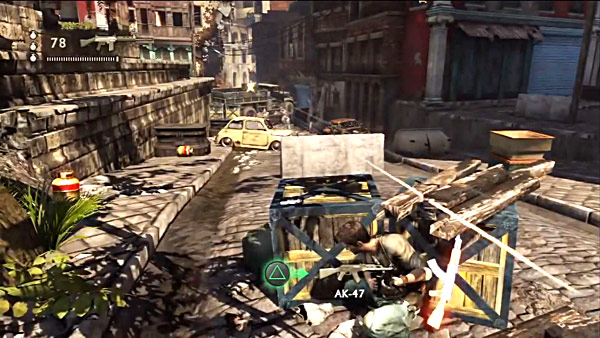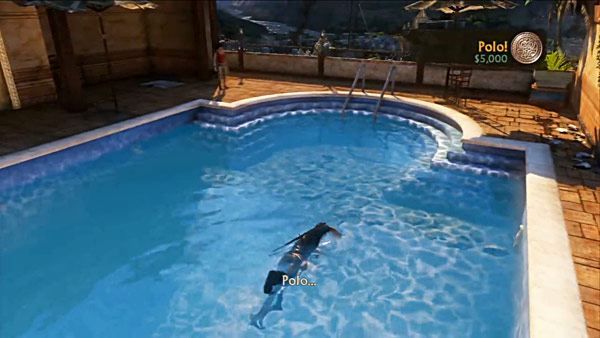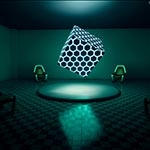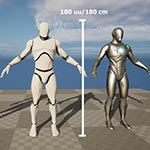World of Level Design™
Tutorials to Becoming the Best Level Designer and Game Environment Artist (since 2008)
Single Player Level Design Pacing and Gameplay Beats - Part 3/3
Category: Level Design
August 24, 2015

click on image to view full size
"Uncharted 2" ©Sony Computer Entertainment America LLC; Dev: NaughtyDog IncThe following is the third and final part of a 3-part tutorial series for single player level design. It is focused on pacing, gameplay beats and how to structure your level design narrative storytelling to a cohesive gameplay experience. All 3 tutorials were written and contributed to World of Level Design by Pete Ellis. Make sure you start with the first part of the tutorial series.
All 3-parts of the series are linked below:
- Single Player Level Design Pacing and Gameplay Beats - Part 1/3
- Single Player Level Design Pacing and Gameplay Beats - Part 2/3
- Single Player Level Design Pacing and Gameplay Beats - Part 3/3
Following article was written and contributed by Pete Ellis, a level designer at Guerrilla Cambridge. Pete has worked on "Killzone: Shadow Fall" and "Killzone: Mercenary" games. He is currently working on "RIGS"; a competitive arena FPS title for PlayStation 4 which utilizes Morpheus VR headset. Visit Pete Ellis website and you can find Pete on Twitter.
In this tutorial you will learn:
- How to combine gameplay beats, pacing, level difficulty and storytelling narrative into a cohesive single-player level design experience
- One thing that will help you craft level design combat gameplay sections within the narrative of the game
- Level design pacing examples from Naugty Dog's Uncharted 2: Chapter 6 - Desperate Times
- How to change things up so every level doesn't follow the same pacing pattern
- What to do with middle sections of your levels to keep the player engaged and interested
- How to use contrast to improve gameplay pacing
- Creating "calm before the storm" moments
- Setting up main battle sequences
- How to break up boss battle sequences into multiple parts
- Creating intensity through dramatic sequence set pieces rather than combat
- Establishing and rewarding a boss battles
This article is the third installment in a three-part article that looks at pacing and gameplay beats in level design, using 'Killzone Mercenary' as a working example, as well as looking at another example of pacing using a level from 'Uncharted 2'.
How Do We Add This All Together?
So, we've worked out the gameplay beats and the pacing and now we must combine them to flesh out this skeleton framework.
We have thought out how our pacing will go in terms of the combat encounters, but we haven't yet organised them into where exactly they should go in the level. We also know that we need to keep the mechanics and activities as varied as possible so the experience doesn't become repetitive.
So how will the combat merge with the rest of the level, whilst maintaining enough lulls or rest periods, and mixing the activities up for the player?
Well, the good news is that the planned out gameplay beats already provide us with a good foundation to merge combat in between. The gameplay beats already provide moments of the game where there has to be no distractions and so here are our planned out areas of rest. They also include expositional sequences (rescuing the Admiral, and the lift ride) as well as traversal or non-combat activities such as learning the D-charge (and an additional tutorial we also added in of learning the touch-screen 'hacking' mechanic).
These differing activities mean that combat would fit in nicely between them so that we give the player a varied experience throughout the level. It also provides us with our lulls so that we know where we can ramp up the intensity in between, using the pacing we planned.
This is how the level timeline worked out, including iterations we made during production.
The final level timeline of 'Halls of justice':

click on image to view full size
I have found that even in games that focus primarily on combat, the best thing to do is to work backwards from the battles. If you focus too much on the fighting, you will struggle to fit in the rest of the level's narrative, or have no space for elements such as making sure the player has learnt the mechanics necessary for completing the level's challenges. If you start with the negative space, the lulls, the rest periods that allow the level's story to be told, you can craft a better supporting experience around it.
Pacing Example From 'Uncharted 2' - Chapter 6 'Desperate Times'
One of my favourite games is 'Uncharted 2: Among Thieves' and one of my favourite levels in this game is chapter 6 'Desperate Times', which is an excellent example of a well-paced level. If you haven't played this game then this section contains spoilers - and I'd also highly recommend you play it!
A level timeline created to illustrate the pacing for Chapter 6 – 'Desperate Times' from Uncharted 2:

click on image to view full size
From analysing the pacing of this chapter in terms of combat intensity you can see that it can be roughly divided up into three sections:
- The initial setup of the combat that establishes war torn Nepal
- Traversing through a hotel to gain access to a high vantage point and the complication
- Subsequent resolution of a helicopter attack
Even though this can be measured in three acts at a chapter level, it is important to note that not every level should follow the same pattern as this will become predictable and repetitive. This chapter is a good example of changing things up. Rather than the level building up with a constant increase of intensity, the opening combat sequence is longer and more intense than the middle section. The last section with the combat against the helicopter is much higher in intensity than both the previous encounters, but it is also split up into two smaller fights. This helps the level to be unpredictable and as a result keeps the player's attention and focus.
This level also has a good example of 'the gap' (as discussed in the first instalment of this article), between the player's expectation and the result. The player is heading to the goal of a temple, but along the way they are ambushed by the helicopter and it forces them to take a second unexpected route that challenges the player, namely fighting a helicopter and surviving a collapsing building. This helicopter attack is the example used in Bruce Straley and Neil Druckmann's GDC 2010 talk of an intense gap that was used to surprise and challenge the player, and introduced at an unpredictable moment
FIRST COMBAT ENCOUNTER - UNCHARTED 2 EXAMPLE
The opening combat encounter of this chapter has three elements to it.
1. Combat against a variety of troopers:
- Pistol Troopers
- SMG Troopers
- LMG Troopers
- Shotgun Troopers
- Riot Shield Troopers
2. Combat puzzle against a static turret
- Defeated by flanking and/or throwing a grenade or throw-able gas canister
3. Combat 'payoff' of using the turret against a focused front of enemies.
The first stage builds up its intensity, starting from a stealth entrance. After a fairly long battle, roughly three minutes, reinforcements arrive in the form of an armoured vehicle that has a turret on the back. This spikes the intensity due to the substantial weaponry combined with additional troopers. This also introduces a combat puzzle for defeating the turret which is protected at the front from conventional firearms; the player has to flank around to the side of it and throw a grenade or a throw-able gas canister, which are pickups in the environment.
The opening encounter starts against troopers, but then peaks with the introduction of a turret:


The third element to this encounter is rewarding the player for defeating the turret by allowing them to use it against a new wave of enemies that enter the environment within the turret's aim. By contrast, this does not further heighten the intensity but instead lowers it as the player is protected by the turrets shield. The enemies are also all within one field of view that the turret can attack, making the battle relatively easy. This is a good way to change things up for the player by not always having the peak of the battle at the end.
The pacing of the opening combat section, where the end of the battle isn't the peak:
LOWER INTENSITY MIDDLE SECTION - UNCHARTED 2 EXAMPLE
The middle section of the chapter is less intense than the opening section in terms of combat. It mainly focuses on different gameplay mechanics as it is primarily traversal, although it does have a few easy combat moments in order to break up the activities of the player.
The player starts by gaining access into a hotel adjacent to the previous combat space, introducing a hard gate so the player cannot go back. Early on in this section the player encounters a shotgun trooper with accompanying enemies inside a much tighter space than they were fighting in previously. The shorter combat distance against this tough enemy makes this initially quite difficult, although there are no backup waves of enemies so it is over relativity quickly. That way it doesn't hinder the movement and progression through the hotel. It would also not suit a longer combat section here in terms of the pacing as the player has just finished a lengthy battle outside.
After defeating the shotgun trooper the player enters into a lift with the buddy character Chloe, which breaks down and the two are separated in a cut scene. This is the start of a new objective where the player must find the circuit breaker to start the lift going again. The player embarks on traversing up through the damaged hotel, moving through precarious spaces that are in contrast to the combat intensity at the beginning.
Chloe and Drake being separated in the lift marks a new objective requiring a longer traversal section that breaks up the combat:

Also worth noting in this screenshot is an excellent re-use of the environment; showing the player where they have come from as well as highlighting the danger they are in:

Half way through the middle section a small number of troopers are introduced into the traversal environment in order to keep this calmer section from becoming dull. As this is not intended on being a big combat sequence, troopers are only introduced either in isolation or in pairs. This keeps the player from getting too comfortable with not being in danger and the game maintains their attention.
Troopers inside the damaged hotel traversal section are introduced in isolation or pairs:

The middle section of the level has a lower combat intensity than the beginning or the end, and focuses mainly on traversal rather than combat:

THE POOL - UNCHARTED 2 EXAMPLE
At the end of the traversal section the player finds the circuit breaker and opens the lift to rescue Chloe. From here they climb up a ladder on to the roof of the hotel, closing a hatch behind them; another hard gate where the player cannot go back.
On top of the roof is a swimming pool. This pool is an absolute stroke of genius, and a really great example of where the lull or trough in the action is as important as the spike or peak. This section is the moment of calm before the storm; it's just before the big peak in the action where the helicopter attacks. This is a really important placement for this element as it creates the greatest contrast between the two moments, and this contrast is what the player experiences from the change in pacing. For example, if the helicopter was introduced right after the opening combat section when the combat intensity was already raised, then there wouldn't be such a contrast in intensity and the helicopter wouldn't have as dramatic an introduction as was intended.
The pool is brilliant because it is an element of playful downtime; the player can play at their leisure and spend as much or as little time with this jovial act as they like, setting their own duration for the period of calm. In fact, the player doesn't have to interact with the pool at all if they choose not to, but what is good is that the buddy character Chloe doesn't push the pacing forward. She is instead static rather than leading the player onwards and she waits for the player, allowing them to take their time.
The pool is here specifically to include this tranquil moment; this is not included to teach the player the swimming mechanic or to remind them of it as swimming is not used again in the game for a few more chapters. There are also two trophies included with interacting with the swimming pool, 'Marco' and 'Polo', which are awarded if the player spends time swimming. In order to gain the trophies, Drake and Chloe share a playful interaction of dialogue which shows and reinforces the relationship between them. This cleverly positioned downtime not only adds to the pacing, it also contributes to the character development.
The roof top pool is the period of calm before the helicopter attack, it also has trophies for spending time to playfully swim:


HELICOPTER ATTACK - UNCHARTED 2 EXAMPLE
The helicopter attack is one of the most stand-out sequences in the game, which also incorporates perhaps the most dramatic set piece of the collapsing hotel. The helicopter attack lasts roughly the same duration as the opening combat encounter, however it is split into two halves. There is a break in between the two halves where there is no combat and only traversal so that it gives the player a much needed break from the high intensity action. As this helicopter sequence has the highest combat intensity in the chapter, it would have been too much for the whole sequence to be continuous, given its duration. Including a moment of calm in between the two halves allows the player to reflect on the drama that has just unfolded, as well as allowing for the contrast between the calm and the second half to make the helicopter's second sequence as dramatic as possible.
The explosive introduction of the helicopter:

The helicopter sequence has an explosive start with it attacking the player whilst they jump precariously across unstable roofing. The player soon encounters a group of three soldiers who are also aggressively attacking them, whilst the helicopter continues to target them throughout the environment, acting as an extra aggressor. The player does not have the weaponry to defeat the helicopter at this stage, so they must instead attack the soldiers whilst avoiding the additional danger. The helicopter attacks with a turret, so the addition of rapid enemy fire against the player makes fighting the three soldiers very tough and dramatic, raising the combat intensity to something far higher than just three soldiers on their own.
The player cannot initially defeat the helicopter, so has to avoid it whilst also combating enemy soldiers on the rooftops:

Once the soldiers are defeated the helicopter continues to chase the player across the roof tops until they get inside the hotel. From here the player isn't safe from the helicopter as it introduces the use of its rockets in set locations that create openings in the side of the hotel. It can target the player through these openings whilst they continue to fight through the hotel corridors; the combat intensity stays high throughout this section.
The last section with the helicopter is the highest intensity of the level. Due to its duration, a lull and break in the action is well-placed in the middle, breaking it into two halves:

Inside the hotel, as the player gets through the enemy soldiers inside, they eventually drop into a floor (creating another hard gate) which has no visible exit. This open office environment has a small number of soldiers inside that are fairly open and not in cover, mainly situated in positions so that the player faces the back wall. This is not a tough fight in itself, although very early on the helicopter blows open the wall that the player is facing. Instead of firing the rapid fire turret inside, as it had previously done, it instead fires more rockets which hit the hotel exterior and cause it to start collapsing.
This is the biggest peak of intensity in the chapter, created through drama rather than difficulty of combat, where the environment starts to move and rotate, causing the cover elements in the scene to slide around and crash against each other. The environment eventually collapses, falling forward into an adjacent building that the player must jump to in order to avoid death. This is an extremely dramatic climax to the first section of combat against the helicopter.
The collapsing of the hotel is one of the most dramatic sequences of the game:

After the hotel collapses there is a period of calm between the two helicopter sections. This lull in the action is where the player traverses through the environment to eventually be ambushed by the helicopter for the final time. The traversing of climbing through the buildings helps to break up the activities so the player is not constantly shooting and using the combat mechanics. This is an excellently placed break in the action given the duration of the entire helicopter sequence, and allows the player to reflect on the high point of the hotel collapsing. The helicopter could have still been in the environment immediately afterwards and that would have made sense, however choosing to give a break from the action amplifies the previous event. This lull also makes sure that when the helicopter arrives for the last time, the sequence is a dramatic conclusion to the chapter.
When the player progresses onwards and the helicopter arrives again, the environment is split into two separate sections. The first section, where the helicopter is reintroduced, also has a small number of soldiers that the player must fight against, whilst also defending against the helicopter. The player still does not have any weaponry strong enough to defeat the helicopter and the buddy character Chloe is also fighting alongside them so the intensity is similar to the first combat encounter with the helicopter.
Once these soldiers are defeated, the player can jump into the second section, (causing a hard gate where the player cannot backtrack), where the new enemy soldiers are now equipped with grenade launchers. This provides the player with the weaponry to defeat the helicopter and so when the soldiers in this section are defeated no more reinforcements arrive and the player can focus on attacking the helicopter.
In the second encounter with the helicopter, the player can now defeat it using the grenade launcher:

This fight with the helicopter is very high in combat intensity, matching the drama of the first half of the encounter. The roof top the player is on is fairly small, but Chloe stays in the first half of the environment so that she is not in the way or taking up cover positions. This also means she does not contribute to the fight (as she does not have a rocket launcher) so does not add to the damage dealt to the helicopter, as well as not taking any of the focus and attention away from the player. This ensures that this section is the tough final battle the player would expect from the vehicle that caused so much destruction in its lead up.
Once the player defeats the helicopter it crashes into the streets below. The remaining part of the chapter is the player and Chloe traversing off the roof tops towards a zip-line for their escape. This zip-line breaks whilst in use, sending the player to the streets below to traverse over the burning debris of the helicopter; in turn re-establishing to the player their achievement of defeating it. This traversal section is a short period of downtime for the player to reflect on the activities they have just undertaken before a cut-scene starts, which requires the player's attention again.
This is the book end to the chapter where Drake meets Elena and her cameraman Jeff, giving the player exposition to their previous relationship and the reason for their presence in the environment. It also sets up the new goal and objective for the player. This cut-scene lasts for around 3 to 4 minutes, and is also a period of calm where the player can relax before the next chapter starts.
After defeating the helicopter the player traverses over the burning debris and meets Elena and Jeff the cameraman in a cut-scene, marking the end of the chapter:


CONCLUSION - UNCHARTED 2 EXAMPLE
The developers of 'Uncharted 2', Naughty Dog, are masters of the narrative driven single player game. When it comes to pacing and gameplay beats, they have demonstrated that careful consideration of where the lulls are placed amplifies the peaks in the action and drama that they are after.
This chapter is also a good demonstration for showing that a level shouldn't be constant action, and in order to get the most dramatic moments it is important to include periods of calm for contrast. Even during sections of prolonged calm they have shown that small snippets of action are sometimes welcome in order for the player to not get too relaxed from feeling safe, and this will maintain their attention and interest.
They use a good balance of activities to focus on in order to stop a level from becoming repetitive and predictable. They have also demonstrated that it is important to change up what convention states; chapter 6 being a good example of where the intensity does not necessarily need to crescendo in order to have a compelling level.
We can use examples of compelling levels to deconstruct their pacing and gameplay beats, and use this for influencing how we create our own levels. If we are struggling to strengthen the drama of a given set piece, it's always worth considering if perhaps the subtractive method is appropriate; removing some of the intensity and action by adding a lull can amplify the following action piece by contrast.
The level timeline for the pacing for Chapter 6 – 'Desperate Times' from Uncharted 2 shows the peaks and troughs that make a compelling level:

click on image to view full size
All 3-parts of this series are below:
- Single Player Level Design Pacing and Gameplay Beats - Part 1/3
- Single Player Level Design Pacing and Gameplay Beats - Part 2/3
- Single Player Level Design Pacing and Gameplay Beats - Part 3/3
Further Reading
References
Following article is copyright ©Peter Ellis 2015
Killzone™ Mercenary is the property of Sony Computer Entertainment ©2013. Killzone is a trademark of Sony Entertainment Europe. Killzone: Mercenary is a trademark of Sony Computer Entertainment America LLC
Uncharted 2: Among Thieves is the property of Sony Computer Entertainment America LLC ©2009. Created and developed by Naughty Dog, Inc
Home Terms of Use/Trademarks/Disclaimers Privacy Policy Donate About Contact
All content on this website is copyrighted ©2008-2024 World of Level Design LLC. All rights reserved.
Duplication and distribution is illegal and strictly prohibited.
World of Level Design LLC is an independent company. World of Level Design website, its tutorials and products are not endorsed, sponsored or approved by any mentioned companies on this website in any way. All content is based on my own personal experimentation, experience and opinion. World of Level Design™ and 11 Day Level Design™ are trademarks of AlexG.
Template powered by w3.css



 UE5: How to Download and Install Unreal Engine 5 in 5 Minutes
UE5: How to Download and Install Unreal Engine 5 in 5 Minutes UE5: 11 Principles to Learning and Using UE5 as a Complete Beginner
UE5: 11 Principles to Learning and Using UE5 as a Complete Beginner UE5: Crash Course Quick-Start Guide to Begin Using UE5 - TODAY
UE5: Crash Course Quick-Start Guide to Begin Using UE5 - TODAY UE5: Complete Guide to Player Scale, Dimensions and Proportions
UE5: Complete Guide to Player Scale, Dimensions and Proportions UE5: Fundamentals Vol.1 - Essential Beginner's Guide to Getting Started
UE5: Fundamentals Vol.1 - Essential Beginner's Guide to Getting Started



